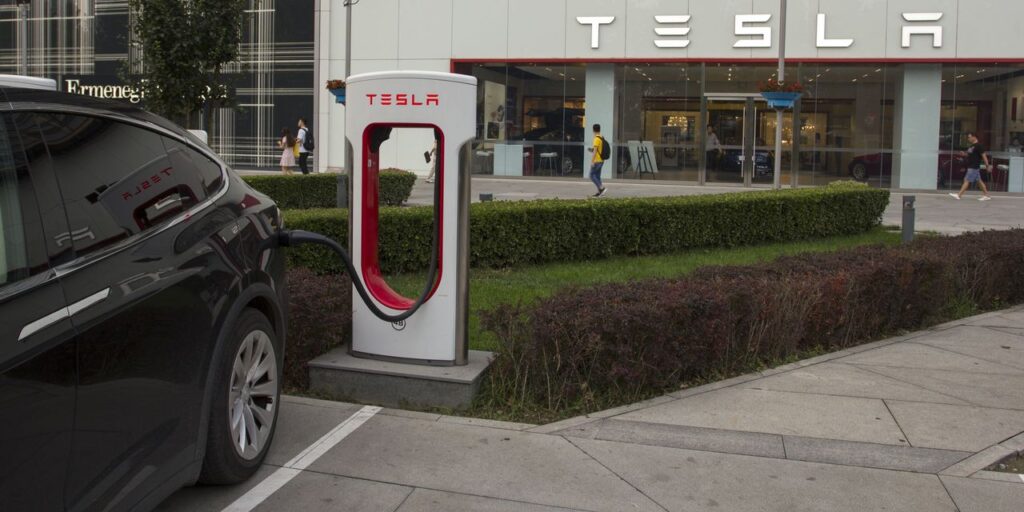Tesla will sell car insurance, but electric-vehicle insurance and repairs are more expensive than for traditional cars. Here’s why. – MarketWatch

The answer is, well, both.
That’s because insurance premiums are built on damage and repair histories, which for EVs is small, yet expanding. EVs are, in many ways, more simply built, with less components, than traditional cars.
But the experts allocated to fix them are still getting up to speed. And parts —semiconductor chips, for starters — can be hard to source, or are subject to trade conditions, even before COVID-19 supply-chain issues disrupted the flow of goods.
“There’s a lack of data or experience with insuring and fixing EVs,” said Bradley Lane, an urban planning professor in the School of Public Affairs and Administration at the University of Kansas, who has focused on EV policy.
“This relative inexperience with the potential full range of things that can go wrong or be replaced encourages insurers to hedge their bets against potentially large, but not-yet-experienced, payouts for claims,” he adds.
Indeed, Lane compares this situation of freshman repair workers and relatively new EV insurance policies to Farmers Insurance commercials where actor J.K. Simmons says, “We cover it all, cause we’ve seen it all.”
“The average cost of repairs are nearly 3% higher for a small EV versus a small internal-combustion engine car.”
The average cost of repairs are nearly 3% higher for a small EV versus a small internal-combustion engine car, says CCC Intelligent Solutions, a data and consulting firm that has examined the impact of EVs on the automotive, insurance and repair industries.
The same researchers found that spending on replacemet parts as a share of the overall repair costs was higher for a small EV despite that EV having 9.1 parts replaced per claim on average, versus 9.6 parts for small ICE cars. Access the full report here.
“The repair and replacement parts for many components of EVs are different from gasoline cars, and their relative scarcity/lack of economies of scale, plus their higher price, means that the insurance premiums to cover them are also higher,” said Lane of the University of Kansas.
“‘As EVs become increasingly mainstream and more insights become available, current insurance premium gaps may close.’”
“The lack of historic data insight on EV claims, and the requirement for some specialist parts, different servicing and battery costs may be attracting higher premiums,” agreed Sarah Larner, EVP of strategy and innovation at Wejo.
Wejo operates a software and analytics platform that processes large amounts of connected-vehicle data. Connected vehicle data is used to show a car’s location, speed, engine issues, and more, delivered through an app or other collection means.
“Transportation and mobility are changing with the increased purchase of EVs and investment in charging infrastructure and services,” Larner added. But as EVs become more mainstream, she said, “current insurance premium gaps may close.”
Today, nearly 80% of industry-wide repairable appraisals for EVs come from a single
automaker that manufactures only EVs where comparison to a similar ICE vehicle is not possible.
However, analysis of the remaining 20% of EVs where a subset of
models can be compared to similar ICE-powered models shows this segment can only grow, CCC said. The latter references makers such as Toyota, Ford
F,
GM
GM,
and others who sell both traditional autos and are adding to their EV offerings.
The EV insurance market will continue to grow
U.S. sales of new EVs, hybrid gas/electric and other types of plug-in hybrid vehicles surpassed 100,000 for the first time ever in mid-2021, accounting for nearly 9% of all new vehicle sales and doubling their share of sales versus a year earlier, according to industry-tracker Cox Automotive.
A host of new electric models are scheduled to appear in the U.S. market over the next couple of years. And these new models are coming in all shapes and sizes, as documented by Consumer Reports.
As the EV market evolves, so will the market to insure it. In fact, Tesla
TSLA,
and more recently, General Motors, are banking on that growth. They’ll not only sell you an EV, they will sell you auto insurance directly, depending on the state.
“Tesla’s auto insurance offering is now available in Florida, Texas, Illinois, Ohio and California. ”
Tesla’s insurance offering is now available in Florida, Texas, Illinois, Ohio and California. The company hopes to have its coverage available to 80% of its U.S. customers by the end of the year, chief financial officer Zach Kirkhorn said during the company’s latest earnings conference call last month.
Consumers should be aware that automakers can’t directly sell insurance in all states, however.
“To introduce new insurance products and policies, the product would need to be sold by a licensed insurer and be approved by the state,” a spokesperson for the National Association of Insurance Commissioners, which represents state-level regulators, said. “States have different requirements.”
In general, “policy language must not violate state law. Rates must be justified (backed by data) and approved by state regulators,” the NAIC said.
Wedbush analyst Dan Ives told CNBC in anGM, which revived its old GMAC insurance unit as OnStar Insurance in 2020, says it hopes to hit $6 billion in yearly insurance revenue by decade’s end. interview that Tesla could insure 300,000 cars by 2025. “This is a 2024-2025 initiative, but they are laying the foundation,” he said.
What kind of EV are you buying anyway?
And, as with any vehicle, more than one factor is at work in setting EV coverage premiums.
“Most EVs on the market today are luxury cars, which cost more to insure in general,” said Chris Harto, Consumer Reports senior sustainability policy analyst, in a guide on the CR site. Luxury has higher replacement value “regardless of whether they’re electric or gasoline-powered.”
“‘Teslas, the data show, are less likely to be stolen than comparable gas-engine luxury vehicles and they track well in the event they are stolen…’”
Data provided by The Zebra, an insurance comparison website, and reviewed by Consumer Reports, shows that a Chevrolet Bolt EV costs $184 more per year to insure than a Honda
HMC,
Insight hybrid. A Nissan Leaf
7201,
costs $42 less per year than a Toyota Prius
TM,
which is a hybrid.
In the upper end, however, a Tesla Model 3 costs $318 more per year to insure than an Audi A4, a relatively comparable gasoline-powered car.
It’s also important to consider what kind of the multiple types of insurance — collision, liability, uninsured motorist, personal injury, medical payments and comprehensive, which covers hail damage or theft — are most suitable.
“Teslas, the data show, are less likely to be stolen than comparable gas-engine luxury vehicles and they track well in the event they are stolen, because of onboard software,” said Rich Gibson, senior casualty fellow at the American Academy of Actuaries.
Key questions to ask before buying
Insurance cost and associated questions should be part of EV decision. After all, they’re already more likely to hit buyers with higher upfront sticker price.
That sting can be softened by current tax incentives in some states, like California, a federal tax program, and the possibility that a stalled Build Back Better spending bill in Congress could deliver more EV help if passed.
With gas prices hitting $4 per gallon, fuel savings and other factors kick in lowering the price of ownership over the life of the vehicle, but the insurance industry sees a chance to jump in the “green” movement as well.
It never hurts to ask your insurance agent even before you car shop. Travelers Insurance
TRV,
for one, rewards customers with a discount if they own or lease a hybrid/electric, similar to how it reduces costs for drivers with clean accident and speeding records.
CCC, the auto and insurance consultants, found that occupants in EVs and hybrid gas/electric models are less likely to be injured in a crash than people in similar gas-powered vehicles.
“‘The big-ticket items on an EV are its battery and its onboard computer system. Ask: How good is the insurance company at covering these features?’ ”
Another consideration: Will you get the follow-up insurance-claim assistance you expect if you go with an auto dealer-generated policy, such as those select options pushed by electric-car vehicles?
“Insurance companies are in the insurance business, and cars are just one thing they insure; they can allocate costs around their portfolio as needed,” the University of Kansas’s Lane said.
“Car companies are in the car business, and don’t necessarily have the experience in the industry or holding other types of insurance to balance out costs across a portfolio,” Lane added. “They may get it in and find it’s a more expensive and cumbersome process than they thought, and prices end up going up for everyone.”
So, what should you ask your insurance agent? “You want to ask the same types of questions that you would about any other car, just tailored to an EV. For example, the big-ticket items on an EV are its battery and its onboard computer system,” Lane advised.
“Ask: How good is the insurance company at covering these features? What are the factors that influence their premium for the car? Is accident liability any different? How about medical and uninsured coverage? What are the damages they don’t cover?”
Read MarketWatch’s latest EV coverage:
This content was originally published here.




Responses